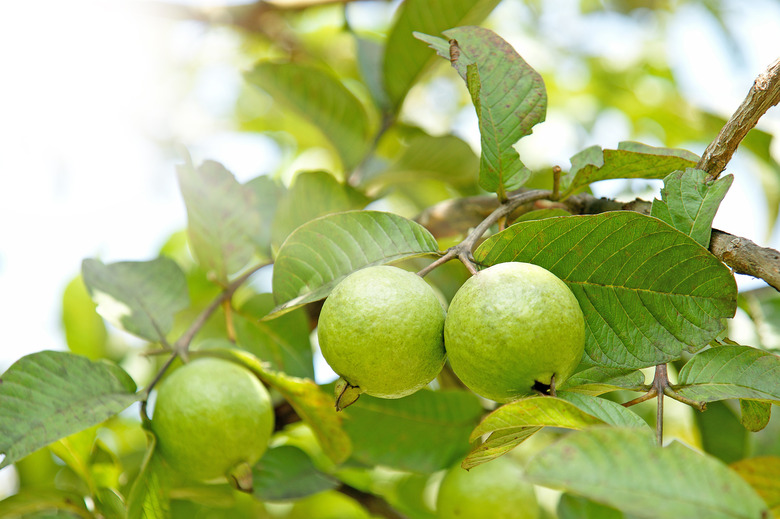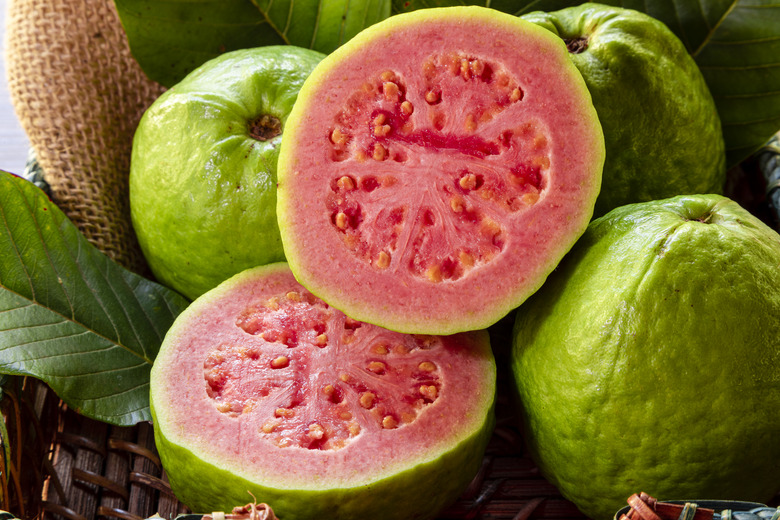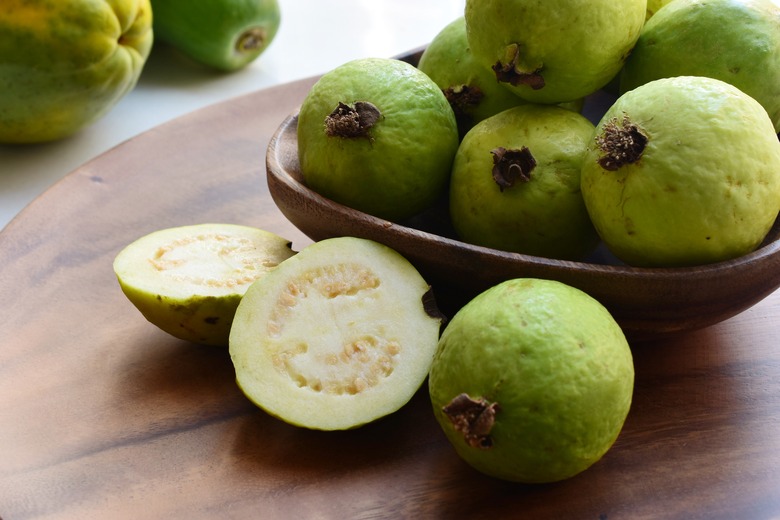Types Of Guava Trees That Can Grace Your Garden
We may receive a commission on purchases made from links.
At first glance, all guava trees (Psidium guajava) look the same. They share similar traits and growth habits, and most produce similar oblong or rounded fruit. The main difference between guava trees lies within their fruit, which has flesh that ranges in color from red to white. There are even several varieties of fruit, such as pineapple guava, that share the common name guava that aren't true guavas despite their similar appearance.
General Guava Characteristics
General Guava Characteristics
All guava trees are small trees with a single or multi-trunked growth habit, a rounded shape, and mottled bark. Most reach 6 to 12 feet high, although those grown in warmer subtropical areas can reach 20 to 30 feet under ideal conditions. All types possess aromatic evergreen leaves and produce fragrant flower clusters that later mature into fruit, if pollinated.
Guava trees grow best in U.S. Department of Agriculture plant hardiness zones 9 to 11, although they must be protected in USDA zone 9 to survive the winter. Guavas are classified as a noxious weed in warm climate areas such as Hawaii, the U.S. Virgin Islands, and southern Florida, where they have escaped cultivation and become invasive. Check these factors if you're thinking of planting fruit trees like guava varieties.
Pink- and Red-Fleshed Guava Varieties
Pink- and Red-Fleshed Guava Varieties
Sometimes referred to as dessert guavas, pink- and red-fleshed guava varieties produce sweet, intensely fragrant fruit. A common variety is the 'Homestead' guava (Psidium guajava 'Homestead,' growing in USDA zones 9a to 11), which produces fruit with sweet, flavorful flesh featuring a deep salmon-pink color.
Another pink-fleshed variety is 'Hong Kong Pink' (Psidium guajava 'Hong Kong Pink,' USDA zones 9b to 11), which produces large quantities of round, 6- to 8-ounce fruits. The pink-fleshed fruit ranges from sweet to mildly sub-acidic with a smooth texture and few seeds. 'Red Indian' (Psidium guajava 'Red Indian,' USDA zones 9b to 11) is an older pink-fleshed guava variety noted for its sweet, high-quality fruit. Despite their seediness, the fruit is good for eating raw.
White- and Yellow-Fleshed Guava Types
White- and Yellow-Fleshed Guava Types
White- or yellow-fleshed guavas typically produce mild, acidic fruit with little to no fragrance. The flesh ranges from creamy white to pale yellow, and the skin typically stays green when ripe, although some varieties develop a pinkish blush. Common white-fleshed varieties include 'Mexican Cream' (Psidium guajava 'Mexican Cream,' USDA zones 9b to 11) and 'White Indian' (Psidium guajava 'White Indian,' USDA zones 9b to 11), both of which produce small- to medium-sized fruit with pale flesh. 'Mexican Cream' is noted for the sweet flavor of its fruit, while 'White Indian' produces somewhat tart and seedy fruit.
'Detwiler' (Psidium guajava 'Detwiler,' USDA zones 9b to 11) stands out with its medium to large fruit, which is often 3 inches in diameter. The pale flesh ranges from yellowish to almost salmon pink and is noted for its sweetness and flavor. Another variety that produces a heavy crop of large fruit is 'Sweet White Indonesian' (Psidium guajava 'Sweet White Indonesian,' USDA zones 9b to 11). It's a fast-growing variety noted for its tasty, 4-inch-diameter fruit.
Guava Tree Relatives
Guava Tree Relatives
A handful of other fruit varieties bear the common name guava, including the strawberry guava (Psidium littoral or Psidium cattleianum, USDA zones 9 to 10) and pineapple guava (Feijoa sellowiana), which doesn't belong to the guava genus, Psidium. The strawberry guava tree bears a close resemblance to the tropical guava, and it produces similarly sweet, almost spicy fruit. The fruit is typically 1 to 1 1/2 inches in diameter with wrinkled red skin and creamy white flesh. It's suitable for jellies and cooking, as well as fresh eating.
The fruit of pineapple guava trees share a flavor similar to tropical guavas, but they have rough, dark green skin even when ripe. Pineapple guava trees typically reach a mature height of 10 to 15 feet with an equal spread, making them suitable for use as a fruiting hedge or specimen shrub in USDA plant hardiness zones 8 to 10. Both strawberry and pineapple guavas grow well in containers, which makes it possible to cultivate them in cooler climates outside their preferred hardiness zone range.


